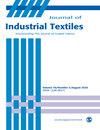Reactive eco-friendly dyeing of natural fabrics using a novel herbal composite containing extracts of Hemigraphis colorata and Bacopa monnieri
IF 2
4区 工程技术
Q1 MATERIALS SCIENCE, TEXTILES
引用次数: 0
Abstract
Terrestial herbs and aquatic herbs are of natural origin with significant medicinal properties. These properties were selected and aimed to provide antimicrobial and anti-odour activities after finishing with nine different fabric samples in the present study. Hemigraphis colorata and Bacopa monnieri are the two herbs selected and a novel herbal composite (HC1) was developed. Composite was finished onto fabric samples using Pad-dry cure process. Finished fabrics were subjected to antibacterial activity using standard EN ISO 20,645 test method against Escherichia coli and Staphylococcus aureus. To prevent odour from physical activities, aromatic oil was finished onto fabric samples; followed by testing anti-odour activity using Swiss standard SNV 195,651. Test results of antibacterial activity of herbal composite (HC1) finished fabrics revealed good inhibitory action against both test bacteria. Aromatic efficiency of herbal composite finished fabrics showed significant aromatic efficiency. Statistical evaluation determined that there was no significant difference (p–1) between finished and control fabrics in terms of antibacterial activity and aroma. Results for the biocompatibility of the herbal composite finished fabrics revealed that the composite concentrations did not inhibit the growth of fibroblast cells; thus indicating the biocompatibility of the herbal composite finished fabric samples. The present study would be considered highly significant by providing an eco-friendly and sustainable products for developing medical textile products and smart home textile products.天然织物的活性环保染色使用一种新型草药复合材料,其中含有半花草和假马齿苋的提取物
陆地草本植物和水生草本植物是天然的,具有重要的药用价值。在本研究中,我们选择了这些特性,目的是在九种不同的织物样品整理后提供抗菌和抗臭活性。以半金莲和假马尾草为研究材料,开发了一种新型复方药材HC1。采用垫干固化工艺在织物样品上制备复合材料。用标准EN ISO 20,645对大肠杆菌和金黄色葡萄球菌进行抗菌活性测试。为了防止身体活动产生的气味,在织物样品上涂上芳香油;然后使用瑞士标准SNV 195,651测试抗气味活性。草药复合材料(HC1)整理织物的抑菌活性测试结果表明,其对两种试验菌均有良好的抑制作用。草本复合整理织物的芳香效率显著。统计评估表明,在抗菌活性和香气方面,成品织物和对照织物之间没有显著差异(p-1)。结果表明,中药复合整理织物的生物相容性对成纤维细胞的生长没有抑制作用;从而表明草药复合整理织物样品的生物相容性。本研究为医用纺织品和智能家用纺织品的开发提供了一种环保、可持续的产品,具有重要意义。
本文章由计算机程序翻译,如有差异,请以英文原文为准。
求助全文
约1分钟内获得全文
求助全文
来源期刊

Journal of Industrial Textiles
MATERIALS SCIENCE, TEXTILES-
CiteScore
5.30
自引率
18.80%
发文量
165
审稿时长
2.3 months
期刊介绍:
The Journal of Industrial Textiles is the only peer reviewed journal devoted exclusively to technology, processing, methodology, modelling and applications in technical textiles, nonwovens, coated and laminated fabrics, textile composites and nanofibers.
 求助内容:
求助内容: 应助结果提醒方式:
应助结果提醒方式:


